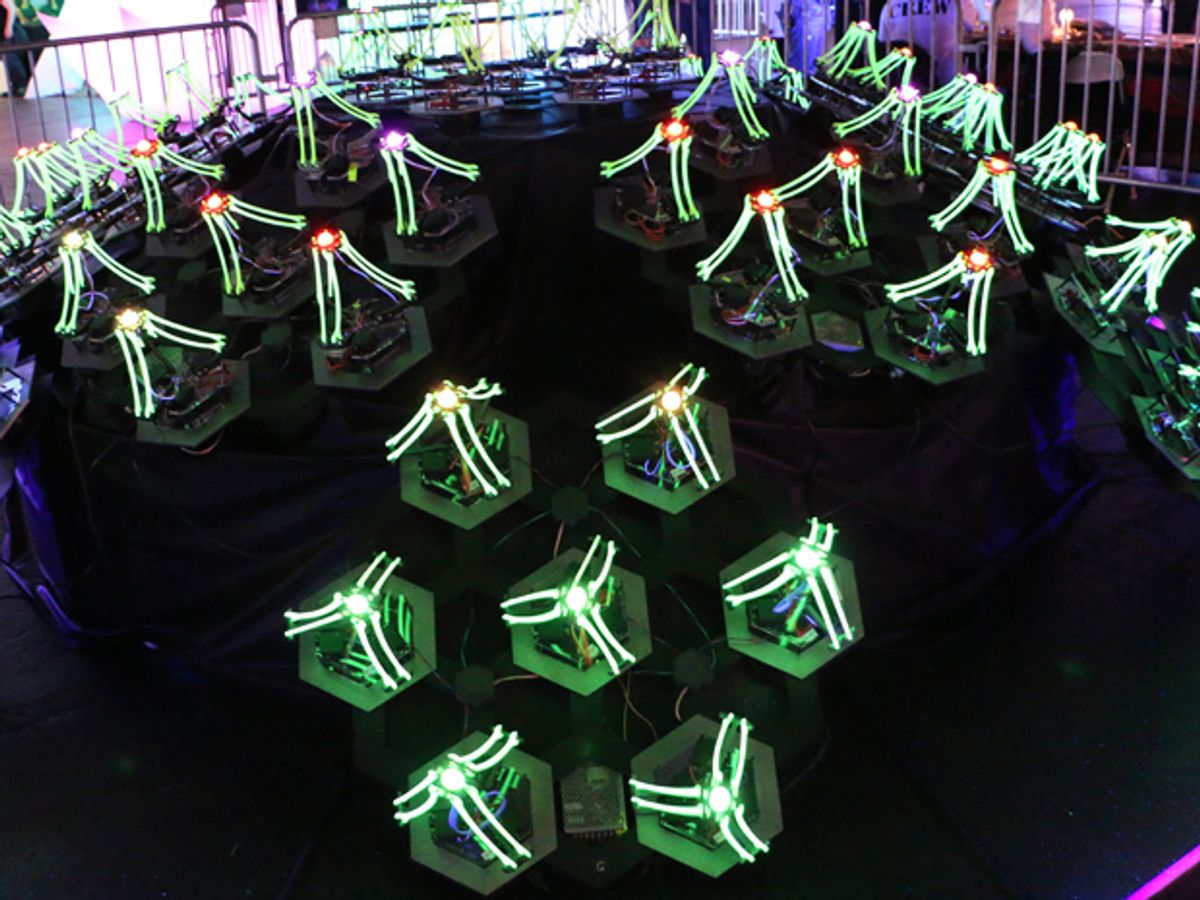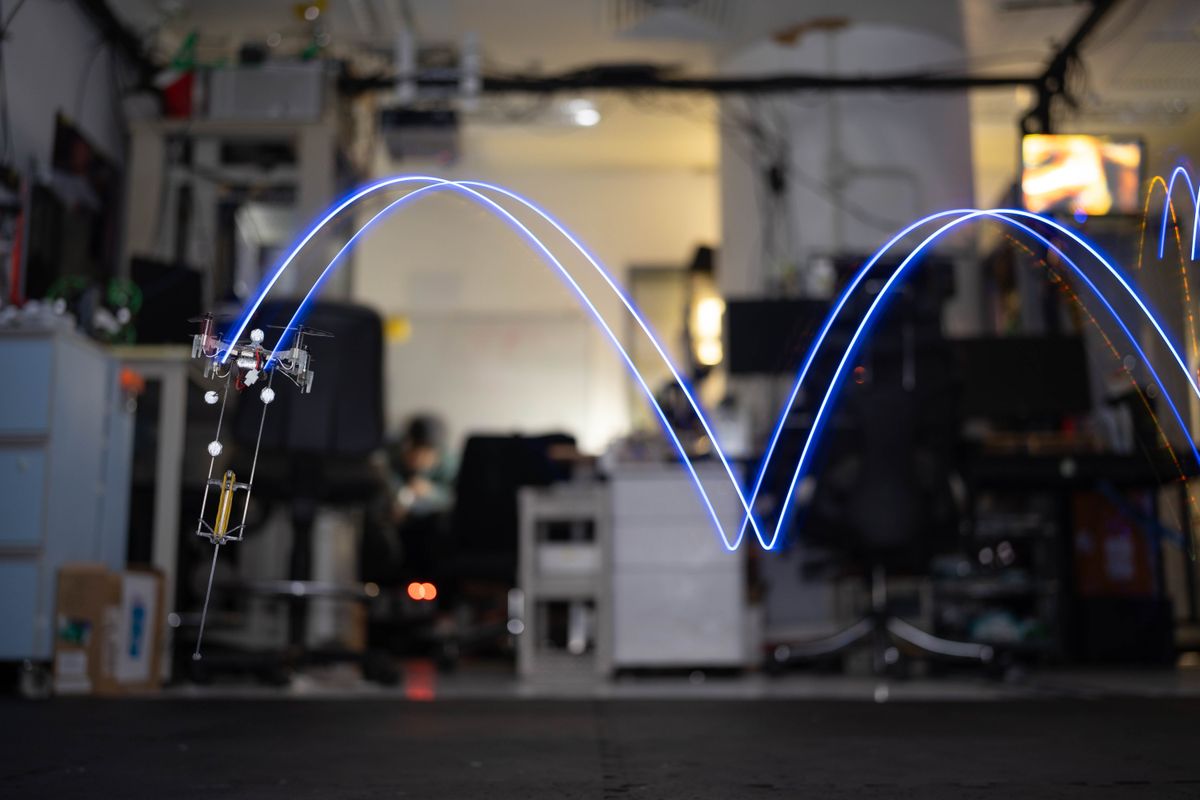Maker Faire Bay Area 2015—a festival of exhibits from tinkerers, tech enthusiasts, and crafters—celebrated its 10th anniversary this weekend.“It’s probably our most complex event,” says Dale Dougherty, Maker Faire founder. “It invites people from all around the world to come show what they’re doing.”
I experienced most of it including dancing robots, animatronic amusements, skating bots, and a DIY roller coaster. Here are the highlights:

Maker Faire’s “Dark Room” was like walking into a nightclub of glow-in-the-dark pop locking robots. A 4.5-meter diameter dome, covered with 84-autonomous delta robots with LEDs wired to their heads, instantly lit up the room.
“Each robot thinks it’s a stage light,” says Sarah Petkus, a freelance illustrator and art-technology enthusiast. Petkus and Mark Koch, an electronics engineer at Blue Man Group, designed and constructed the Light Play installation, which is part of Robot Army’s 2014 Kickstarter campaign.
Every few minutes, the robots cycled between preprogrammed sets of swirling, twisting, and bobbing motions–all while beaming red, blue or green spotlights. Under the black light, each robot’s 3-D printed plastic legs glowed neon green, so from afar, the installation looked like a hill of waving grass. The dome shape accentuated a geometric kaleidoscope effect.
Of the US $25,000 raised in Robot Army’s Kickstarter, approximately $10,000 was used to 3-D print robot components in Petkus and Koch’s Las Vegas home. It took nearly six months to print. “We had assembly parties every other week,” Petkus says.

There’s something about looking at a life-sized animatronic character that’s both intriguing and a bit frightening, which is probably what drew me to Roy the Robot.
“Any movement that a human can do, he can do right now, aside from shoulder shrug,” says Brian Roe, a robotics expert and co-host of Science Channel’s television show, “All-American Makers.” Once an avid animatronics builder for films, now, he builds these life-like robotic characters for fun.
Roe designed Roy the Robot to perform 48 individual upper torso movements and used a laser cutter to sculpt each section out of plywood. Roy’s motions are controlled using Arduinos and Adafruit servo boards. They’re all under the control of Roe’s PC and Visual Show Automation software. That’s an animation program that lets him control up to 246 servos of live animation in order to choreograph complex animatronic, audio, video, and lighting shows.
Roy the Robot blossomed after Roe built one eye, which led to a set of eyes, which eventually led to a hand, and so on. “It continued to build until finally I’m sitting here with a half a Roy,” he says. Although Roy may never walk or run, Roe says that one day he would like to build Roy all the way down to his feet.

Glider, an 11-kg multimodal hexapod robot recently won gold medal at RoboGames 2015 in the walker challenge. But it’s an accomplished skater too.
“I was skating around with him earlier,” says Nick Donaldson, Glider’s creator. Educated as a mechanical engineer, Donaldson eventually co-founded a software company. “You put mechanical engineering and software together, and you get a robot,” he says.
It took Donaldson more than a year to design, procure, build, and program Glider. The inline skate wheels, which are mounted at an angle to its aluminum legs, allow the bot to push outward and skate across flat surfaces. Powered by a 1.86 GHz Intel Atom and controlled using a PlayStation 3 controller, Glider maxes out at a walking speed of 0.4 meters per second and a skating speed of 2.5 meters per second.
Despite Glider’s recent gold medal, Donaldson is still tinkering around with the robot’s machine vision so that can track human faces while keeping them in view.

If your child asked you to build a roller coaster in your backyard, would you?
In 2013, after riding roller coasters all day, Will Pemble’s son, Lyle, asked him that very question and he said, “Yes– that would be cool.” Together, they started The CoasterDad Project and this year’s Maker Faire showcased the roller coaster they built in their front yard (plus an additional 14 meters of track).
Pemble is a management consultant and founder of ProtoPalette, an Arduino learning kit that teaches kids about electronics and coding. Pemble studied aeronautics in college, but he is a self-taught roller coaster maker.
In total, the roller coaster had 73 meters of track, two helix turns and nearly a 3 meter drop with a “wild mouse turn”, as it’s known by roller coaster enthusiasts. A motorized chain lift brings the cart to the top lift hill, which is about 5 meters long and 3 meters tall. A 1.5-horsepower electric motor powers the chain. Pembles says it’s similar to a motor found in a household washing machine.
“It’s a pretty energetic ride,” Pemble says. Once the cart is at the top, gravity takes care of the rest. After the first drop, the cart reaches about 27 km/hour.
Theresa Chong is a video host and multimedia technology journalist based in Palo Alto, Calif. As on-camera talent, she has performed science experiments for “Discovery News,” explained how virtual reality works for USA Today, and interviewed Adam Savage for IEEE Spectrum. She has written about wearables for Scientific American and travel tech for Architectural Digest. With a DSLR, GoPro, and green screen by her side, she has produced digital videos of robots, driverless cars, and 3D printing. She earned a master’s degree from Northwestern University’s Medill School of Journalism, and in a prior life she worked as a civil engineer.



